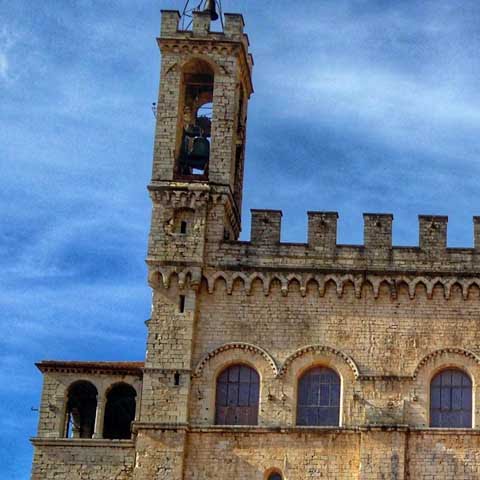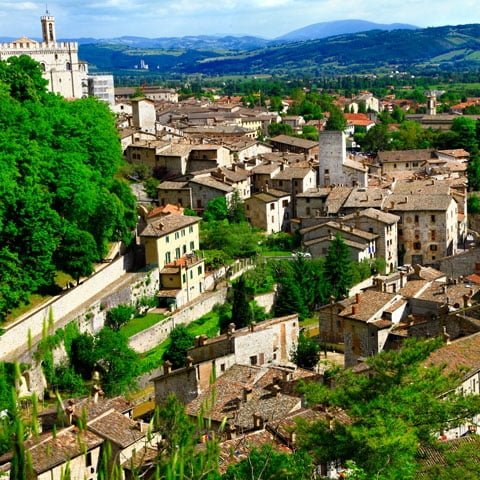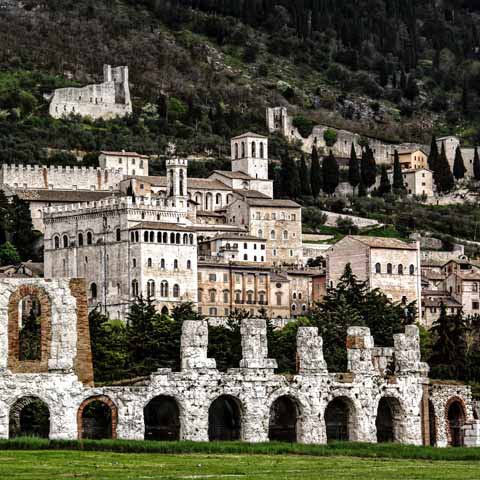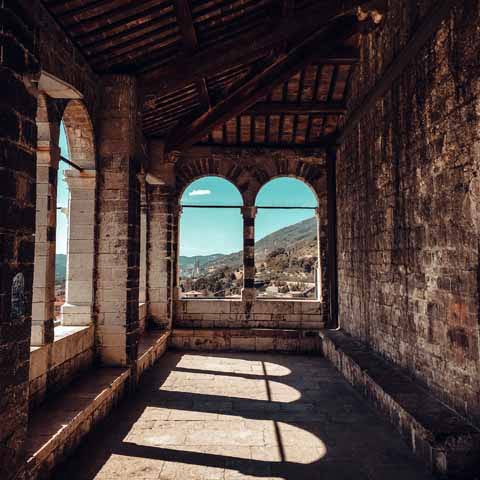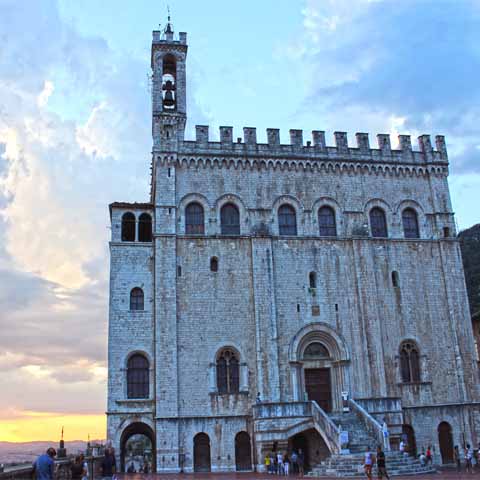While in Umbria, a region known for being soft, green, and lush, travelers can experience a bit of Italy’s more medieval history in Gubbio. The town, which is characterized by being more dark, imposing, and Gothic than the rest of Umbria, is one of the region’s most beautiful and historic hill towns.
Tucked away in the foothills of Umbria, Gubbio is a quiet and somewhat isolated city. Travelers can experience hillside views and historic sightseeing throughout the city without the overrun of large crowds of tourists.
Like much of Italy, the city’s culture and atmosphere are reminiscent of its history, which dates back to its founding in the third century BC when it was originally called Ikuvium or Iguvium. At the time, the city was a political and religious power.
In the first century AD, Gubbio solidified itself as a historically important city when it was known as the Roman town of Iguvium. Legend states that Rome would exile madmen to Gubbio, and this history can be seen today in Gubbio in the Palazzo el Bargello’s Fountain of the Fools. Tradition states that visitors to the fountain must run around the fountain three times to become a “madman of Gubbio.”
After the fall of the Roman Empire, Gubbio passed between the hands of the Goths, Byzantines, and Lombards. In the early 1000s, the city was under siege by a dozen Umbrian cities until Saint Ubaldo saved the city by convincing Holy Roman Emperor Frederick Barbarossa to grant Gubbio its independence. The city would go on to be led by many more powers until the early 1600s when it became a part of the Papal States.
Arguably, Gubbio is Umbria’s most medieval town, featuring winding streets, characteristic houses, and medieval style architecture throughout the city. There are even remnants of the imposing medieval walls that protected the city.
The town is known for being the home of the Iguvine Tablets, seven bronze tablets which are considered to be the Rosetta Stone of the Umbrian language. They are the earliest record of the language and are the longest and most important documents for Osco-Umbrian languages.
More history can be found by visiting the city’s Roman amphitheater, opulent palaces, and medieval structures.
Between the city’s historic sites, stunning Alpine setting, and rich culture which can be enjoyed by attending local events and festivals, Gubbio is a wonderful city to visit.
GEOGRAPHY & CLIMATE
Gubbio is located in the region of Umbria, nearly 25 miles north of Perugia. The city is located in Northern Umbria on a low slope of Mount Ingino, one of the smaller mountains of the Apennine range. The city’s location on the foothills of a mountain gives great views of the valley below. Positioned near the border with the Marche region, Gubbio covers a little over 200 square miles.
Gubbio’s climate is temperate and warm, making it a great locale to visit nearly any time of year. While the temperature is comfortable, travelers should be aware that the city receives a noticeable amount of rain throughout the year. Even in the city’s driest month, travelers should expect some rainfall.
WHEN IN GUBBIO
Admire the city walls. Gubbio’s historic city walls, which were completed during the fourteenth century, still stand to this day. The walls will be your constant companion as you explore the city and can be spotted from almost any point in the historic city center. The walls feature six gates that served as the historic entrances into the town. Today, some of the gates still feature centuries-old wooden doors or the remains of historic decorations. Of these gates, the St. Augustine Gate is the most well-preserved.
Visit the Roman amphitheater. One of Gubbio’s most visited sites, the ruins of an ancient Roman amphitheater depict the rich history of the city. The theater was built during Emperor Augustus’ reign and, at the time, the theater was the second largest throughout the Roman Empire. Today, the ruins of the theater, which was greatly damaged during the fall of the Empire, are located in an open field. Travelers can visit the theater for free and admire the backdrop of the mountains as well.
Explore the Palazzo dei Consoli – a palace built in the early 1300s. Located in Gubbio’s main square Piazza Grande, the palace is one of the city’s most stunning medieval structures and houses the Civic Museum of Gubbio. Inside the Civic Museum, travelers will find the historic Iguvine Tablets, a must-see when visiting Gubbio, as well as a variety of archaeological artifacts. The Piazza Grande also features great views over the town and its surrounding countryside.
Ride the unique cable car to the top of Mount Ingino. One of Gubbio’s most unique activities is a ride on the funicular, also known as the Funivia Colle Eletto. This truly one-of-a-kind cable car is open-air, and each car only holds two people standing. The six-minute ride, while not for the faint of heart, will give travelers panoramic views and take them to another one of the city’s best sites.
At the top of Mount Ingino, travelers can visit the Basilica of San Ubaldo. Built in the early 1500s, this Basilica is not only named for Saint Ubaldo, Gubbio’s patron Saint, but it actually houses his body. At the top of the Basilica’s main altar sits a glass casket which holds the body of the Saint himself. In addition, the Basilica houses important artworks.
If traveling in May, a must-see is the Festa dei Ceri, an event also known as Saint Ubaldo Day. This event is Umbria’s largest, most important, and most historic festival. During the festivities, which honor the life of Saint Ubaldo, a massive race occurs. The event features groups of citizens racing with massive pillars, each weighing over 400 kilograms, up the slope of Mount Ingino to the Basilica of San Ubaldo. The pillars represent the Saints Ubaldo, Antonio, and George. Thousands of people attend the celebration, and it is a cornerstone of Gubbio’s culture.
Travel to the scenic region of Umbria and discover the charming city of Gubbio. Renowned for its medieval architecture and the fascinating Festa dei Ceri, Gubbio is one of the best places to get to know the heart of Central Italy.
Travel Guides
The Umbria Region of Italy
The Cities of Umbria, Italy
